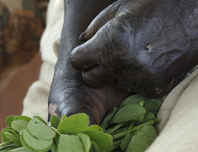 Leprosy, a chronic infectious disease mainly affecting the skin, peripheral nerves, upper respiratory tract and eyes, has impacted people and their societies for thousands of years. Persons with leprosy were ostracized by their communities and families, and looked upon as objects to be feared. But leprosy research has thrived throughout the decades, and the drugs that have subsequently been developed have made leprosy a disease that is curable, and made treatment provided in the early stages successful in averting disability.
Leprosy, a chronic infectious disease mainly affecting the skin, peripheral nerves, upper respiratory tract and eyes, has impacted people and their societies for thousands of years. Persons with leprosy were ostracized by their communities and families, and looked upon as objects to be feared. But leprosy research has thrived throughout the decades, and the drugs that have subsequently been developed have made leprosy a disease that is curable, and made treatment provided in the early stages successful in averting disability.
The disease was first arrested in the 1940s with the development of the drug dapsone. Further research led to the development of a more successful multidrug therapy (MDT). Over the past 20 years, more than 14 million persons with leprosy have been treated, about 4 million of them since 2000. The prevalence rate of the disease has dropped by 90%: from 21.1 per 10,000 persons to less than 1 per 10,000 persons in 2000.
Although leprosy has been eliminated from 119 out of the 122 countries where the disease was considered a public health problem in 1985, persons affected by leprosy continue to face high levels of exclusion in society.
Persons affected by leprosy acquire a disability due to their condition, for instance, facial and other disfiguration as a result of the disease, which further leads to pronounced physical and attitudinal barriers to inclusion in their communities. Historically held fears and assumptions about leprosy continue to promote the pervasive exclusion of persons affected by leprosy from mainstream efforts to include them in society and development.
Exclusion and barriers are often a result of inaction or actions by Governments, healthcare services, educational institutions and their own communities that often lead to social isolation, discrimination and under-representation in the educational, employment and other social domains. Furthermore, persons affected by leprosy are not well represented in the disability rights movement, nationally and globally; a common misconception persists that leprosy is only related to health and is not a disability issue.
The Convention on the Rights of Persons with Disabilities (CRPD) calls upon States Parties to take action to combat such stigma and discrimination, as well as to work to ensure the full and equal participation of all persons with disabilities in society, on an equal basis with others.
Leprosy programmes around the world need to be further improved and must focus on underserved populations and inaccessible areas to improve access and coverage. Persons affected by leprosy who also live with a disability should be empowered in their local communities to raise awareness and help improve the understanding of the disease. Enhancing collaborative efforts between healthcare practitioners and the general public can further help reduce the discrimination and isolation currently experienced by people affected by leprosy within the disability population.
As part of an initiative to include persons affected by Leprosy in the disability movement, Disabled People’s International (DPI) with the support of the Nippon Foundation and DESA will convene an event entitled “Voices of People affected by Leprosy,” during the 8th Session of the Conference of States Parties to the CRPD to be held from 9-10 June 2015.
The Conference of States Parties to the CRPD is the world’s largest and most diverse global disability meeting that brings together high-level Government officials, UN agencies, leading civil society organizations, including organizations of persons with disabilities, academia, practitioners and service providers. The event on leprosy hopes to draw greater attention to issues by sharing the concerns of persons with leprosy with this key audience to better ensure that their voices and needs are included in the global disability and development agenda.
For more information:
Disabled Peoples International
